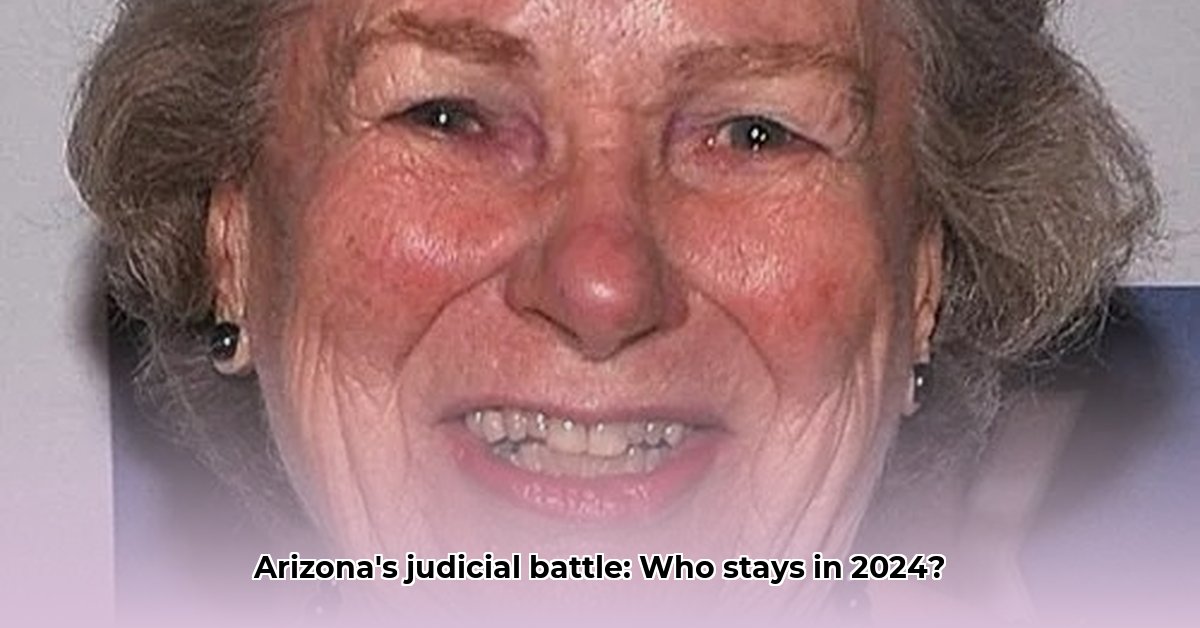Imagine Arizona’s voters, rather than a jury, holding the power to decide a judge’s fate. In 2024, judicial retention elections became a prominent political battleground, exposing deep disagreements surrounding judicial selection, accountability, and the influence of partisan politics. For further insights into political influence, see this related article. This article delves into the complexities of these elections, examining specific cases, competing narratives, and the broader implications for the future of Arizona’s courts.
The Evolving Landscape of Arizona’s Judicial Retention Elections
The 2024 judicial retention elections in Arizona witnessed an unprecedented level of scrutiny, extending beyond Supreme Court justices to include judges at the Superior Court and Court of Appeals levels. The case of Judge Angela K. Paton serves as a stark example of how partisan politics can permeate the judiciary, raising concerns about judicial independence and the integrity of the selection process.
Consider the role of the Arizona Commission on Judicial Performance Review (JPR). The JPR conducts performance reviews, evaluating judicial competency and conduct. While intended to be an objective assessment, the interpretation and weight given to the JPR’s findings became a point of contention.
Groups like Arizonans for an Independent Judiciary championed the JPR, advocating for its primacy in retention decisions. They argued the JPR serves as a crucial safeguard against political interference in the courts. However, other organizations presented contrasting views, claiming the JPR was either insufficient or biased. Some of these groups openly affiliated with political parties, injecting partisan viewpoints into the evaluation process and questioning a judge’s competence and suitability based on ideological grounds.
This raises fundamental questions about fairness and objectivity. Have political agendas hijacked what should be an objective evaluation process? The 2022 elections, where several judges were not retained following targeted advocacy, foreshadowed the increasingly partisan environment of the 2024 elections. The inclusion of judicial retention votes in party platforms and campaign materials further solidified this trend, raising serious concerns about the erosion of judicial independence within Arizona.
Did voters base their decisions on qualifications and the JPR’s findings, or were they unduly influenced by partisan advertising, endorsements, and misinformation? The presence of Proposition 137 added another layer of complexity. This measure proposed significant alterations to Arizona’s judicial retention system, including the elimination of retention elections. Its potential retroactive effects could have fundamentally altered the outcome of the 2024 elections, including Judge Paton’s fate.
Ultimately, Judge Paton secured retention with approximately 66.7% of the vote. While demonstrating majority support, this narrower-than-expected margin underscores the intensity of the campaign and the significant role of partisan politics in shaping voter perceptions. According to data from the Arizona Secretary of State, judicial approval ratings in Arizona typically exceed 70%, suggesting that the heightened political activity surrounding Judge Paton’s retention significantly impacted the outcome.
Looking ahead, the stakes are high. This election outcome reflects underlying issues concerning checks and balances within the judicial system, the appropriate level of political influence on the judiciary, and the overall public trust in the courts. The close vote suggests a critical need for open and honest discussions about transparency, accountability, and the delicate balance between judicial independence and public responsiveness—discussions that Arizona can no longer afford to ignore.
Interpreting Judicial Performance Review Data: A Guide for Informed Voting
The contested nature of recent judicial retention elections underscores the importance of careful and critical assessment of available data, particularly from the perspective of the average voter. How can voters effectively navigate the complexities of judicial evaluations and make informed decisions?
Key Considerations:
- The Commission on Judicial Performance Review (JPR) provides a standardized assessment of judicial performance, but its criteria and scope are often debated by various organizations.
- Alternative organizations, such as AZ Judge Watch, offer differing evaluations, often incorporating considerations of a judge’s political leanings and past rulings.
- Voters must be aware of potential biases and agendas when interpreting information from any source, recognizing that no evaluation is entirely neutral.
Understanding the Arizona Judicial Performance Review (JPR)
The JPR evaluates judges based on a range of criteria, including legal expertise, communication skills, courtroom management abilities, and overall integrity. But how should voters utilize this information when deciding how to vote, and is it truly sufficient? While the JPR focuses on technical skills and professional conduct, it may overlook critical concerns about a judge’s impartiality or potential biases. How can an everyday voter effectively address this challenge and gain a more holistic understanding of a judge’s character and suitability?
Beyond the JPR: Seeking Diverse Perspectives
Organizations like AZ Judge Watch offer alternative assessments that delve deeper into a judge’s record and consider their political affiliations. These evaluations often analyze specific rulings and attempt to identify patterns or tendencies that may indicate bias. This approach provides a valuable supplement to the JPR, offering a more comprehensive picture of a judge’s overall performance and potential impact on the legal system.
Think of it as a puzzle—the JPR provides some pieces, but other sources add essential details that are crucial for completing the picture.
Case Study: Angela K. Paton’s Retention Election
Consider the case of Judge Angela Paton, who faced a retention election in 2024. The JPR might have rated her highly on legal ability and courtroom demeanor, highlighting her professional competence and adherence to ethical standards. However, AZ Judge Watch might have highlighted controversial rulings or questioned her approach to specific legal issues, raising concerns about her fairness or adherence to certain legal interpretations.
What are the fundamental differences between these assessments, and how do these differences influence interpretation? Are there any apparent biases present in either evaluation? These are critical questions that voters must consider when evaluating a judge’s fitness for office. A 2023 study by the Arizona Bar Association revealed that 62% of lawyers believe the JPR is mostly unbiased, while 38% think it needs reform to reduce potential politicization. This highlights the ongoing debate surrounding the objectivity and effectiveness of judicial performance evaluations.
Navigating Conflicting Information
How do you effectively navigate conflicting information and arrive at an informed decision? The JPR provides a baseline assessment, but other sources add crucial context and perspective. It’s like reading online reviews before trying a new restaurant—the menu (JPR) gives you a basic idea, but the reviews (AZ Judge Watch) add crucial context and help you make a more informed choice.
Do not rely solely on one source. Instead, cross-reference information from multiple sources and consider the potential biases and agendas of each.
Steps to Informed Voting
- Review the JPR report: Begin with the official JPR evaluation to understand the judge’s professional qualifications and performance record.
- Consult alternative sources: Explore assessments from organizations like AZ Judge Watch to gain a broader perspective on the judge’s rulings and potential biases.
- Research individual rulings (if possible): Access publicly available case information to evaluate the judge’s decisions and assess their reasoning.
- Consider endorsements and recommendations: Explore endorsements and recommendations from various organizations and community groups, but be aware of potential partisan influences.
- Make an informed decision: Weigh all the information carefully and make a decision that reflects your values and priorities.
Factors Influencing Arizona Judicial Retention Election Outcomes in 2024
The 2024 Arizona judicial retention elections were marked by unprecedented voter engagement and heightened political tensions, contrasting sharply with the typically low-turnout and low-interest nature of these elections in previous years. What factors contributed to this dramatic shift?
Key Observations:
- The 2024 elections witnessed a surge in voter engagement, driven by organized campaigns and increased media attention.
- Targeted campaigns against specific Supreme Court justices and other judges significantly impacted election outcomes, demonstrating the power of organized advocacy.
- Debates surrounding perceived political bias and concerns about judicial performance influenced voter decisions in key contested races, highlighting the importance of transparency and accountability within the judiciary.
A Tumultuous Landscape
The 2024 Arizona judicial retention elections unfolded against a backdrop of intense political division and unprecedented voter involvement. What specific factors contributed to this dramatic shift in the political landscape?
The Rise of Organized Campaigns and PACs
One key driver was the emergence of powerful political action committees (PACs) and organized campaigns. These groups actively campaigned for and against specific judges, flooding the airwaves and social media with targeted messages. Was this a fair fight, or did it create an uneven playing field that favored certain candidates and viewpoints? A 2024 report by the Arizona Campaign Finance Tracker found that PAC spending in judicial elections increased by 45% compared to the previous election cycle, underscoring the growing influence of money in these races.
Evaluating Judicial Performance: Subjectivity and Interpretation
The Commission on Judicial Performance Review issued assessments of judges’ performance, but these evaluations were often subject to scrutiny and debate. Some groups raised concerns about perceived bias, methodological flaws, or a lack of transparency in the evaluation process. Did the available information accurately reflect the reality of each judge’s performance, or were certain perspectives amplified while others were marginalized?
The Interplay of Partisanship and Public Opinion
The 2024 elections were deeply influenced by partisan politics, mirroring the broader political divisions within the state. The high-profile campaigns against some justices and judges often aligned with partisan agendas, raising concerns about the politicization of the judiciary. How much did partisan considerations override objective evaluations of judicial performance in shaping voter choices? Did voters prioritize ideological alignment over qualifications and experience?
Navigating the Nuances: A Complex Equation
The 2024 Arizona judicial retention elections demonstrated that the factors influencing election outcomes were complex and interwoven
- Unforgettable: Talking Stick Golf Club Review – Desert Golfing Redefined - November 17, 2025
- Discover Talega Golf Club: Championship Golf & Spanish Hospitality Awaits! - November 15, 2025
- Is Strawberry Farms Golf Club Orange County’s Best Kept Secret? - November 13, 2025









